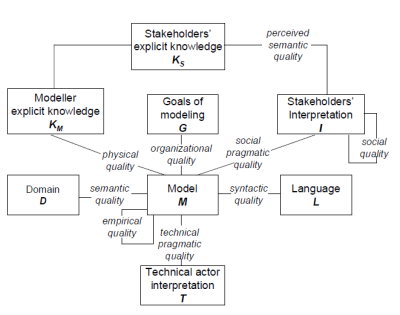Table of Contents
Model Quality
Metrics improve development process, understanding of complexity, discovering/predicting faults and estimation of efforts. Often the choice of metrics exceed what is required and therefore it is advised to define what is the purpose of measurement..
Framework for Deciding Metrics
Goal-Question-Metric Framework
A useful framework to derive useful metrics is the Goal-Question-Metric (GQM) paradigm developed by Basili 1). The GQM process is as follows:
- Define goals of measurement (for “UML As Sketch” type models then goal is mainly focusing on communication.)
- Define questions to which the answers allow the observer to determine whether the goal has been met
- Each question is evaluated to determine what metrics are required to support the question's answer.
Krogstie's framework
Krogstie's framework2) is a framework which lays out that quality goals are defined as relations between blocks.
- Syntatic quality - goal that all statements in the model are according to the syntax of the modeling language
- Empirical quality - comprises comprehensibility matters such as layout and readability
- Organizational quality - model fulfills the goal of modeling
- Social quality - agreement between stakeholder's intepretations
No known empirical evaluation of this framework on models.
Quality Goals
Mohagheghi3) show that there are 6 classes of quality goals for models:
- Comprehensibility (emphasis for model sketches)
- Confinement (emphasis for model sketches)
- Correctness (emphasis for model design)
- Completeness (emphasis for model design)
- Consistency (emphasis for model design)
- Changeability (emphasis for model design)
- Comprehensibility - Model is understandable to its intended audience.
- Confinement - Model is in agreement with its purpose
- Correctness - Model includes correct elements & relationships. Does not violate rules and conventions
- Completeness - All necessary information is included at the necessary degree of fidelity
- Consistency - Model is without contradictions. Horizontal consistency is consistency between diagrams and views that belong same level of abstraction. Vertical consistency is consistency between models or diagrams at different levels of fidelity. Consistency also refers to semantics, i.e. same element does not have multiple interpretations
- Changeability - Model supports continuous and rapid improvement and evolution
MIT xPRO propose the following “Qualities of Great Models”
- Linked to Decision Making.
- Model Credibility - it is believable
- Clear Scope
- Verification and Validation of Model - Model should show why it is the preferred option to do verification and validation of the system
- Traceable and Analyzable
- Understandable and Well Organized
- Data extrapolation - where is the model valid
- Complete relative to Scope
- Internally consistent
- Verifiable
- Validatable
- Elegant
- Appropriate level of Fidelity
- Allows Optimization - does it includes gradients or convexity
- Avoid optimization on a black box
- Reuse
- Availability of Interfaces
Model Metrics
Model Size
- Rationale includes:
- Comparison of models (before and after, model A and model B on same system)
- Measure of progress
- Prediction of work effort
- Examples4):
- Absolute size (e.g. number of elements)
- Relative size (e.g. ratio between sequence diagrams and use cases)
- Complexity (…)
- Functionality (e.g. number of use cases)
- Re-use (e.g. applicable if a profile is used, then the metric may be % of profile usage)
Design Metrics
Rationale for the below metrics is to measure the quality of detailed design and implementation
- Degree of Polymorphism5) - the extent to which a method of a class over-rides the class' inherited method from its parent class.
- Degree of Information Hiding - the extent that a class' variables and methods are encapsulated. A private element is fully hidden.
Complexity Metrics
- Weighted Methods Per Class (from Chidamber & Kemerer6) OO metrics suite) - Number of Methods defined in class. High is Complex
- Depth of Inheritance Tree (a CK metric) - Maximum inheritance path from the class to the root class. Deeper a class the more it is likely to inherit, therefore increasing complexity. High is Complex
- Number of Children (a CK metric) - Number of immediate sub-classes of a class. Low is Complex
- Coupling between Object Classes (a CK metric) - A coupling is present when method declared in one class use methods in another class. High is Complex
- Response for a Class (a CK metric) - A response set of method that can potentially be executed in response to a message received by an object of that class. High is Complex
- Lack of Cohesion (a CK metric) - Lack of cohesion between methods. Identifies classes that attempt to achieve many objectives. High is Complex
Comprehensibility Metrics
- Number of elements on diagram
- Number of crossing lines on diagram
- Number of entry and exit points on diagram

